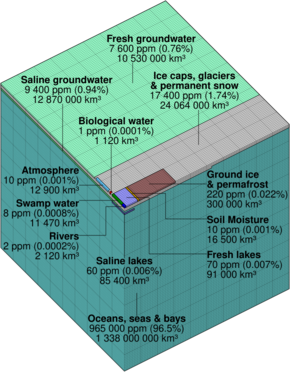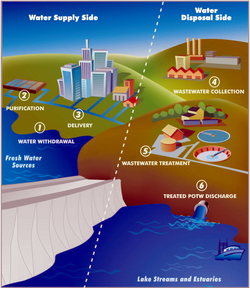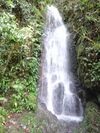Water resource management
Topic: Earth
 From HandWiki - Reading time: 9 min
From HandWiki - Reading time: 9 min
Water resource management is the activity of planning, developing, distributing and managing the optimum use of water resources. It is an aspect of water cycle management.
Water is essential for our survival. The field of water resources management will have to continue to adapt to the current and future issues facing the allocation of water. With the growing uncertainties of global climate change and the long-term impacts of management actions, the decision-making will be even more difficult. It is likely that ongoing climate change will lead to situations that have not been encountered. As a result, alternative management strategies are sought for in order to avoid setbacks in the allocation of water resources.
Ideally, water resource management planning has regard to all the competing demands for water and seeks to allocate water on an equitable basis to satisfy all uses and demands. As with other resource management, this is rarely possible in practice.
One of the biggest concerns for our water-based resources in the future is the sustainability of the current and future water resource allocation.[1] As water becomes scarce, the importance of water management grows vastly—finding a balance between humans' needs and the essential step of water resources sustainability in the environment.
Overview

Water is an essential resource for all life on the planet. Of the water resources on Earth, only 2.5 percent of it is fresh. Two-thirds of the freshwater is locked up in ice caps and glaciers. Of the remaining one percent, a fifth is in remote, inaccessible areas and much seasonal rainfall in monsoonal deluges and floods cannot easily be used.[3] As time advances, water is becoming scarcer; having access to clean, safe, drinking water is limited among countries. At present, only about 0.08 percent of all the world's fresh water[4] is exploited by mankind in ever increasing demand for sanitation, drinking, manufacturing, leisure and agriculture. Due to the small percentage of water remaining, optimizing the fresh water we have left from natural resources has been a continuous difficulty in several locations worldwide.
Much effort in water resource management is directed at optimizing the use of water and in minimizing the environmental impact of water use on the natural environment. The observation of water as an integral part of the ecosystem is based on integrated water resource management, where the quantity and quality of the ecosystem help to determine the nature of the natural resources. [2]
As a limited resource, water supply poses a challenge. This fact is assumed by the project DESAFIO (the acronym for Democratisation of Water and Sanitation Governance by Means of Socio-Technical Innovations), which has been developed along 30 months and funded by the European Union's Seventh Framework Programme for research, technological development, and demonstration. This project faced a difficult task for developing areas: eliminating structural social inequity in the access to indispensable water and public health services. The DESAFIO engineers worked on a water treatment system run with solar power and filters which provides safe water to a very poor community in the state of Minas Gerais.[5]
Successful management of any resources requires accurate knowledge of the available resources, the uses to which it may be put, the competing demands for the resource, measures to and processes to evaluate the significance and worth of competing demands and mechanisms to translate policy decisions into actions on the ground.[citation needed] Overall, the new management participants need to create new experiences and share their experiences with outsiders to spread the government's message to make these new policies.[6]
For making water as a resource, this is particularly difficult since sources of water can cross many national boundaries, and the uses of water include difficulties to assign financial value and may also be difficult to manage in conventional terms. Examples include rare species or ecosystems or the very long term value of ancient groundwater reserves, sometimes known as fossil water.[2]
Agriculture
Agriculture is the largest use of the world's freshwater resources, consuming 70 percent.[7] As the world population rises, it consumes more food (currently exceeding 6%, it is expected to reach 9% by 2050), the industries and urban developments expand, and the emerging biofuel crops trade also demands a share of freshwater resources, water scarcity is becoming an important issue.[8] An assessment of water resource management in agriculture was conducted in 2007 by the International Water Management Institute in Sri Lanka to see if the world had sufficient water to provide food for its growing population or not .[9] It assessed the current availability of water for agriculture on a global scale and mapped out locations suffering from water scarcity. It found that a fifth of the world's people, more than 1.2 billion, live in areas of physical water scarcity, where there is not enough water to meet all their demands. A further 1.6 billion people live in areas experiencing economic water scarcity, where the lack of investment in water or insufficient human capacity make it impossible for authorities to satisfy the demand for water.[citation needed]
The report found that it would be possible to produce the food required in future, but that continuation of today's food production and environmental trends would lead to crises in many parts of the world. Regarding food production, the World Bank targets agricultural food production and water resource management as an increasingly global issue that is fostering an important and growing debate.[10] The authors of the book Out of Water: From abundance to Scarcity and How to Solve the World's Water Problems, which laid down a six-point plan for solving the world's water problems. These are: 1) Improve data related to water; 2) Treasure the environment; 3) Reform water governance; 4) Revitalize agricultural water use; 5) Manage urban and industrial demand; and 6) Empower the poor and women in water resource management. To avoid a global water crisis, farmers will have to strive to increase productivity to meet growing demands for food, while industry and cities find ways to use water more efficiently.[11]
Managing water in urban settings
The carrying capacity of the Earth is increasing greatly due to technological advances and urbanization, which are caused by an increase in economic opportunities. This rapid urbanization occurs worldwide but is mostly seen in new rising economies and developing countries. Holding many of the wolds megacities (cities or urban areas with more than 10 million inhabitants), China and India are both developing at very high speeds.[12] The number of megacities is projected to continue risking, reaching approximately 50 in 2025.[13] Within developing economies, water scarcity is an extremely common and prevalent issue.[14] Global freshwater resources dwindle in the eastern hemisphere even faster than the poles. Currently, millions of people live with insufficient fresh water.[15] This is caused by polluted freshwater resources, overexploited groundwater resources, insufficient harvesting capacities in the surrounding rural areas, poorly constructed and maintained water supply systems, the high amount of informal water use, and insufficient technical and water management capacities.[16]
In the areas surrounding urban centers, agriculture competes with industry and municipal users for safe water supplies. Through this competition, traditional water sources are becoming polluted with urban runoff. As cities offer the best opportunities for selling produce, farmers often have no alternative to using polluted water to irrigate their crops. Depending on how developed a city's wastewater treatment is, there can be significant health hazards related to the use of this water. Wastewater from cities can contain a mixture of pollutants. Wastewater from kitchens, toilets, and rainwater runoff usually contain excessive levels of nutrients, salts, and a wide range of pathogens. Heavy metals may also be present, along with traces of antibiotics and endocrine disruptors, such as estrogens.[17]
Developing world countries tend to have the lowest levels of wastewater treatment, although in some desert cities of developing countries innovative public- private collaboration has increased wastewater treatment to more than local reuse capacity.[18] Often, the water that farmers use for irrigating crops is contaminated with pathogens from sewage. The pathogens that pose the largest threats are bacteria, viruses and parasitic worms. These pathogens directly affect farmers’ health and indirectly affect consumers if they eat the contaminated crops. Common illnesses include diarrhea, which kills 1.1 million people annually and is the second most common cause of infant deaths. Many cholera outbreaks are also related to the use of poorly treated wastewater. Therefore, efforts to reduce freshwater contamination play a large role in the fight for global health.
Scientists have been working to find ways to reduce contamination of food using a method called the 'multiple-barrier approach'. This involves analyzing the food production process from growing crops to selling them in markets and, eventually, consuming them. Then, considering where it might be possible to create a barrier against contamination. Barriers include introducing safer irrigation practices, promoting on-farm wastewater treatment, eradicating pathogens, and effectively cleansing crops after harvest in markets and restaurants.[19]
Urban Decision Support System (UDSS)
Urban Decision Support System (UDSS) – is a data-driven urban water management system that uses sensors attached to water appliances in urban residences to collect data about water usage.[20] The system was developed with a European Commission investment of 2.46 Million Euros[21] to improve the water consumption behaviour of households. Information about appliances and facilities such as dishwashers, showers, washing machines, taps – is wirelessly recorded and sent to the UDSS App on the user's mobile device. The UDSS is then able to analyse and show homeowners which appliances are using the most water, and which behavior or habits should be avoided in order to reduce the water usage.This allows people to manage their consumption more economically. The UDSS is based in the field of Management Science, at Loughborough University School of Business and Economics, particularly Decision Support System in household water benchmarking, led by Dr Lili Yang, (Reader).[22]
See also
- American Water Resources Association
- eWater
- Hydrological optimization
- Integrated urban water management
- Integrated water resources management
- List of water supply and sanitation by country
- Overdrafting
- Peak water
- Saltwater intrusion and salinization management
- WASH (Water, sanitation and hygiene)
- Water footprint
- Water management hierarchy
- Water politics
- Water resources law
- Water Resources Research
- Water scarcity
References
- ↑ Walmsly, N., & Pearce, G. (2010). Towards Sustainable Water Resources Management: Bringing the Strategic Approach up-to-date. Irrigation & Drainage Systems, 24(3/4), 191–203.
- ↑ 2.0 2.1 2.2 USGS - Earth's water distribution
- ↑ "How Much Water is There on Earth?". https://www.usgs.gov/special-topic/water-science-school/science/how-much-water-there-earth?qt-science_center_objects=0#qt-science_center_objects.
- ↑ Fry, Carolyn The Impact of Climate Change: The World's Greatest Challenge in the Twenty-first Century 2008, New Holland Publishers Ltd
- ↑ "Extend access to water with the help of technology. [Social Impact. DESAFIO. Democratization of Water and Sanitation Governance by Means of Socio-Technical Innovation (2013–2015). Framework Programme 7 (FP7)."]. http://sior.ub.edu/jspui/cris/socialimpact/socialimpact00466.
- ↑ Pahl-Wostl, Claudia; Craps, Marc; Dewulf, Art; Mostert, Erik; Tabara, David; Taillieu, Tharsi (2007-08-20). "Social Learning and Water Resources Management" (in en). Ecology and Society 12 (2). doi:10.5751/ES-02037-120205. ISSN 1708-3087. https://www.ecologyandsociety.org/vol12/iss2/art5/main.html.
- ↑ Grafton, Q. R., & Hussey, K. (2011). Water Resources . New York: Cambridge University Press.
- ↑ "Water in Agriculture" (in en). https://www.worldbank.org/en/topic/water-in-agriculture.
- ↑ Molden, D. (Ed). Water for food, Water for life is A Comprehensive Assessment of Water Management in Agriculture. Earthscan/IWMI, 2007.
- ↑ The World Bank, 2006 "Reengaging in Agricultural Water Management: Challenges and Options". pp. 4–5. http://water.worldbank.org/water/publications/reengaging-agricultural-water-management-challenges-and-options.
- ↑ Chartres, C. and Varma, S. Out of water. From Abundance to Scarcity and How to Solve the World’s Water Problems FT Press (USA), 2010
- ↑ "GES knowledgebase". Global Economic Symposium. https://www.global-economic-symposium.org/knowledgebase/knowledgebase?search-for-keywords-category.detailed:record:str=True&search-for-keywords-category.index:record:str=portal_type&search-for-keywords-category.
- ↑ Open Business, Council (February 28, 2019). "Urban Expansion: China to Lead the World Ranking with 19 Megacities by 2025". https://www.openbusinesscouncil.org/urban-expansion-china-to-lead-the-world-ranking-with-19-megacities-by-2025/.
- ↑ Escolero, O., Kralisch, S., Martínez, S.E., Perevochtchikova, M. (2016). "Diagnóstico y análisis de los factores que influyen en la vulnerabilidad de las fuentes de abastecimiento de agua potable a la Ciudad de México, México" (in es). Boletín de la Sociedad Geológica Mexicana 68 (3): 409–427. doi:10.18268/bsgm2016v68n3a3.
- ↑ Howard, K.W.F (2003). Intensive Use of Groundwater:: Challenges and Opportunities. A.A. Balkema Publishers.
- ↑ Mund, Jan-Peter. "Capacities for Megacities coping with water scarcity". UN-Water Decade Programme on Capacity Development. http://www.worldwaterweek.org/documents/WWW_PDF/2010/tuesday/T5/mund_Capacities_for_Megacities.pdf.
- ↑ Zhang, Fengsong (19 July 2020). "o‐occurrence characteristics of antibiotics and estrogens and their relationships in a lake system affected by wastewater". Journal of Environmental Quality 49 (5): 1322–1333. doi:10.1002/jeq2.20128. PMID 33016441. https://acsess.onlinelibrary.wiley.com/doi/abs/10.1002/jeq2.20128.
- ↑ Ziafati Bafarasat, Abbas (2021). "Is our urban water system still sustainable? A simple statistical test with complexity science insight". Journal of Environmental Management 280: 111748. doi:10.1016/j.jenvman.2020.111748. PMID 33309395. https://doi.org/10.1016/j.jenvman.2020.111748.
- ↑ Ilic, S., Drechsel, P., Amoah, P. and LeJeune, J. Chapter 12, Applying the Multiple-Barrier Approach for Microbial Risk Reduction in the Post-Harvest Sector of Wastewater-Irrigated Vegetables
- ↑ Eggimann, Sven; Mutzner, Lena; Wani, Omar; Mariane Yvonne, Schneider; Spuhler, Dorothee; Beutler, Philipp; Maurer, Max (2017). "The potential of knowing more – a review of data-driven urban water management". Environmental Science & Technology 51 (5): 2538–2553. doi:10.1021/acs.est.6b04267. PMID 28125222. Bibcode: 2017EnST...51.2538E. https://www.dora.lib4ri.ch/eawag/islandora/object/eawag%3A13857/datastream/PDF2/Eggimann-2017-The_potential_of_knowing_more-%28accepted_version%29.pdf.
- ↑ "Integrated Support System for Efficient Water Usage and Resources Management". http://issewatus.eu.
- ↑ Chen, Xiaomin; Yang, Shuang-Hua; Yang, Lili; Chen, Xi (2015-01-01). "A Benchmarking Model for Household Water Consumption Based on Adaptive Logic Networks". Procedia Engineering. Computing and Control for the Water Industry (CCWI2015) Sharing the best practice in water management 119: 1391–1398. doi:10.1016/j.proeng.2015.08.998. https://dspace.lboro.ac.uk/dspace-jspui/bitstream/2134/20832/1/Benchmaring%20model.pdf.
External links
 KSF
KSF

